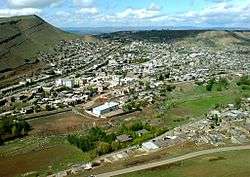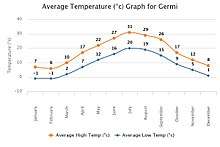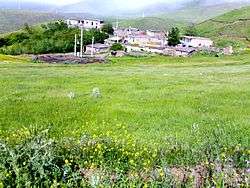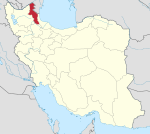Germi
Germi (Persian: گرمي, also Romanized as Germī and Germī; also known as Germi Ojarood)[2] is a city in and the capital of Germi County, Ardabil Province, Iran.
Germi گرمي | |
|---|---|
City | |
 Germi | |
 Germi | |
| Coordinates: 39°01′17″N 48°04′48″E | |
| Country | |
| Province | Ardabil |
| County | Germi |
| Bakhsh | Central |
| Population (2016 Census) | |
| • Total | 28,967 [1] |
| Time zone | UTC+3:30 (IRST) |
| • Summer (DST) | UTC+4:30 (IRDT) |
| Germi at GEOnet Names Server | |
Location
Germi is located 110 km north of Ardabil the capital of Ardabil province. Also, Germi is located about 50 km from the Caspian Sea, It has an average altitude of 1,050 m (3,440 ft) and total area of 1,752 km2 (676 sq mi).
Neighboring on the Caspian Sea and the Republic of Azerbaijan, this city is of great political and economical significance.
It is located on an open plain 1,100 m (3,600 ft) above sea level, just east of Mount Azna (2,100 m).
History
Germi county is a historical region of Iranian Azerbaijandespite Germi city is considered a new city based on Iranian standards, which was established almost in the year 900 of the Islamic calendar (900 AH; 1494 A.D.) when Shah Ismail allowed to 5 Shia families to migrate to this region. The first documentary about this region which is listed in historical books dates back to year 22 Hijri (about 671 ad=Gregorian calendars) when Arab soldiers inter Aran or Alan region[1]. As it is believed before Islam era Alan's people were living in this area. Words such as Alania, Allan-Shahr, Alan-Shahr, and Alan-shah had been used firstly at the first ad century for this district where was located between Azerbaijan, Shirvan, Caspian sea, and Armenia. As it comes out from historical document many Alan people migrated from this area after Islamic era then firstly substitute by Muslim people from different ethnic groups such as Persians, Arabs, Turkmens, and Tatars. After that, the area between those four borders was known as Mugan or Amukan and other pronunciation of them. The most historical place in the county is Barzand Castle that was the castle of Afshin who battled with Babak Khorramdin in an earlier century of Islamic history. People of this county are Shi'a Muslim and speak the Azeri language. The largest river of the county is Dareroud; it issues from southern and eastern foot of Sabalan and joins to Aras river on the northern border of Iran. This river is the largest internal river of the Ardabil Province. [3] [4] [5]
Appellation and etymology
When it comes to the etymology of "Germi" it seems somehow cryptic and there are several hypotheses about the meaning of word "Germi" and historical stem of this city Name. Many historians believe the word "Germi" has Parthian or Alanian stems. Many others suggest ritual words stem from religions such as Mithraism. There is 2 theory that believe Germi is combination of 2 words: "Ger" and "mi" but the interpretation is different: One group believe on Sumerian stem that "Ger" means village and "Mi" means celestial; the others believe "Ger" comes from "Ager" in old Persian language that changed to "Akhgar" at new Persian language, whereas "mi" comes from "mehr" or "Mitra" which both means: "Sun", so "germi" means fireplace of sun. This interpretation is more consistent with other documents and pieces of evidence about this region and its history. First Hypothesis believes. The name Germi probably comes from the Parthian name. The other Hypothesis link this word to Maghoi.There are some other places and cities in East-Azerbaijan province, West-Azerbaijan province, Ardabil province and Azerbaijan republic that are called Germi. [3] [4] [5]
People and culture
Germi is the capital of Germi County. According to the 2017 census, its population was 28,967, in 6,382 families.[6], The dominant majority of whom are ethnic Azeris. Notable for its shawl and carpet and short-napped coarse carpet" trade tradition. The ancient valuable Germi vestige and things are holds in Kashan museum, Iran National Museum, and Copenhagen museum. Germi county is also known as the seat of a World Heritage Site: the first piece of cloth woven in Iran and discovered in Salala Village were to be kept in Iran national museum.
Germi is an ancient city in the Ardabil province of Iran, thought to have been founded in the Parthian period. Germi is located in an area known for temperate weather. It is an important agricultural center, the county seat of Germi County, and the capital of Moghan.[7]
Climate
Germi, like most parts of Iran, has a semi-arid climate with fairly hot summers and relatively cold winters. The climate of Germi is moderate and mild to most of the districts and cities of Ardebil province. The climate of this city, especially in the east, is somewhat influenced by the climate of the Caspian region and its collapse, and most of its settlements in the valleys are exposed by the rapid winds that are in some of the province's provinces such as Ardebil and Meshkinshahr. According to the 50 years precipitation statistics and records, The yearly average precipitation is 360 but annual precipitation varies between 200 up to 450; mm and an average monthly temperature varies from (-2.5 to 29.2 Celsius) allows farmers to reach good yields in growing cereals. Germi also has a lot of winds, but it's not usually sparse. Local people have given them different names depending on the season, temperature, humidity, wind direction and wind power. Germi (the wind that is slowly and partly warm between the plains of the area and its mountains), the Gechi-Qiran (the wind that flows from the north and is very cold) and the promise (which can be called the Saba breeze) is the same as the wind near the spring And Nowruz is gentle and delusional) are famous winds of the region, all of which have a mild speed.
It is said that Mohammad Reza Shah Pahlavi, one of the army's ambassadors, was in charge of traveling to the region in 1956 and the establishment of the city of Moghan. On the trip that took place in the summer, the military commander's wife complained of hot weather in other cities of Moghan, but when Entering Germi, she was excited by the warm and elegant climate and insisted her husband that no city is more deserving of warmth than Moghan. Then the rumors of the local elders and the order of land and land came to the aid because, due to the order of the transactions and the unilateralism of the people, their land became more formal than before, and by following the elders and relying on this warm welcome, the owner of the bank's branch And the General Court had decided to finalize the report of the General to serve the king and mention the strategic and military advantages of the city of Germi and the conditions of that day of the Cold War and the Soviet Union, the state and the court to determine the city of Tabriz as the center of the city.

The average temperature peak in July is up to 31 ° C, while the average minimum temperature in the winter season in February is reduced to a minus 1 ° C. The maximum monthly average rainfall in November and May is 57 and 54 mm, respectively, and the minimum rainfall in July is 15 mm. The maximum monthly average of the days associated with the precipitation of the spring season in May May) is 13 days and the minimum is 5 days in the summer of July. [4] [5] [3]
Demography
- Population (Metropolitan): about 28,000
- Religion: Mainly Shi'a Islam
- Ethnicity: Mostly Azeri
- Language: The majority of the population speaks Azeri.
Attractions
| Attraction | Description |
|---|---|
| The complex Sayyed Mir aziz Mirzadeh Germi | is a holy shrine in east germi |
| Masjid Jameh | Ruins of once magnificent and unique Mosque. |
| saheb alzaman mosque | This complex dates back to Qajar period |
| Germi Khaja nasir school | This beautiful school was built during Qajar period by Russian soldiers. |
| Germi bridges | Germi host numerous historical bridges namely Pol-e Moseyeb, Pol-e Tolon Chay River, most were built during Safavid era. |
and a few ancient bridges. In addition to these, in many villages of Germi, relics of ancient monuments, including tombs have been found.
Being a city of great antiquity, the origins of Germi go back 3000 to 6000 years (according to historical research in this city). This city was the capital of Germi county in different times, but its golden age was in the Parthian period.
Geology
Many cold springs and beautiful natural landscapes are in Germi and around which attract tourists. The mineral springs of Germi (khan bulaghi, Zarana) are notable throughout Iran for their medicinal qualities.
Many beauty lakes: the largest of which are Gilarlul, are the habitats of some species of water birds. The beautiful Lake Gilarlu is located in an open area 03 km north-West of the city of Germi. It covers an area of 1.1 km2 and has an average depth of 1.5 metres. It is fed by Barzand rivers.
| Attraction | Description |
|---|---|
| Lake Gilarlu | located in a hilly area North West of the city of Germi and covers an area of 210,000 m². The surface of the lake is covered with a thin white layer of minerals, being useful for healing skin diseases and rheumatism. Near the lake there is the mud dam complex of Gilarlu. |
| Tulun Chay River | Meaning "a river with quick gradient" in Turkish language, this river originates from the Khan Kandi, Germi Mountains and passes through Germi city. As a result, many villages and townships have settled around this river. It also irrigates much of the agricultural lands in this county. |
| Azna mountain | Azna ( Azna; also called ?zn?) is an inactive stratovolcano in Germi Germi county of north-western Iran about 20 miles south-east of Germi. Azna is the third highest mountain in Germi county. and different tourist areas such as the Tang Village. The mountain is known for its beautiful vistas. |
Music
Colleges and universities
- Payam Noor University of Germi
- Islamic Azad University of Germi
- Jame elmi Karbordi University of Germi
- Islamic Azad University of ungut
- Payam Noor University of Ungut
Economy
The economy of Germi is partially agricultural, partially tourist based, with some industries in operation.
Azar Gapu, the largest door factory of its kind in the Middle East, is located in Germi.
Germi Meteorological Station
Germi Meteorological Station is a synoptic meteorological station located at Germi city of Ardabil province of Iran. It is one of the main international synoptic stations which has been established to provide meteorological services, climate risk management and crisis management in the city of Germi. This station has a significant role in the production of various bulletins to predict the weather in the northern region of Ardabil province. Germi Meteorology prepares and broadcasts various hourly daily reports on the status of atmospheric parameters.Germi Meteorology helps people, especially farmers in Germi city, as well as travelers and tourists, in guiding and informing the weather and weather forecast. Most of the information of Germi Meteorological Station will be published on the website of the Iran Meteorological Organization.[8][9][10][11][12]
See also
- Khan kandi
- Tabriz
- Azerbaijan
 Khankandi village
Khankandi village Khankandi village
Khankandi village Khankandi village
Khankandi village Tulun village
Tulun village Khankandi spring nature
Khankandi spring nature Khankandi Blue Flowers
Khankandi Blue Flowers
References
- https://www.amar.org.ir/english
- Germi can be found at GEOnet Names Server, at this link, by opening the Advanced Search box, entering "-3063628" in the "Unique Feature Id" form, and clicking on "Search Database".
- "گِرمی ؛ یادگار دوره اشکانی". Retrieved 2017-11-08.
- "معرفی شهرستان گرمی". Retrieved 2017-11-08.
- ""گرمی" بهشتی پنهان". Retrieved 2017-11-08.
- "Census of the Islamic Republic of Iran, 1395 (2016)" (Excel). Islamic Republic of Iran.
- Speech by the British Ambassador on Presentation of Credentials
- "وضع هوای گرمی : ایستگاه هواشناسی گرمی". irimo.ir. Retrieved 2017-11-08.
- "Germi Weather - AccuWeather Forecast for Ardebil Iran". accuweather.com. Retrieved 2017-11-08.
- "Täsmäsää Germi". Foreca.fi. Retrieved 2017-11-08.
- "ایستگاه هواشناسی گرمی - دانشنامه جهان". worldpedia.ir. Retrieved 2017-11-08.
- "Germi Weather - worldweatheronline Forecast for Germi Iran". worldweatheronline. Retrieved 2017-11-10.
